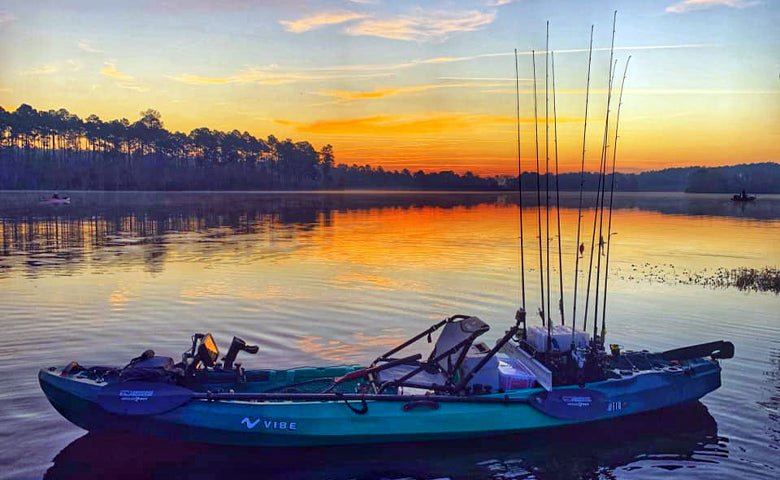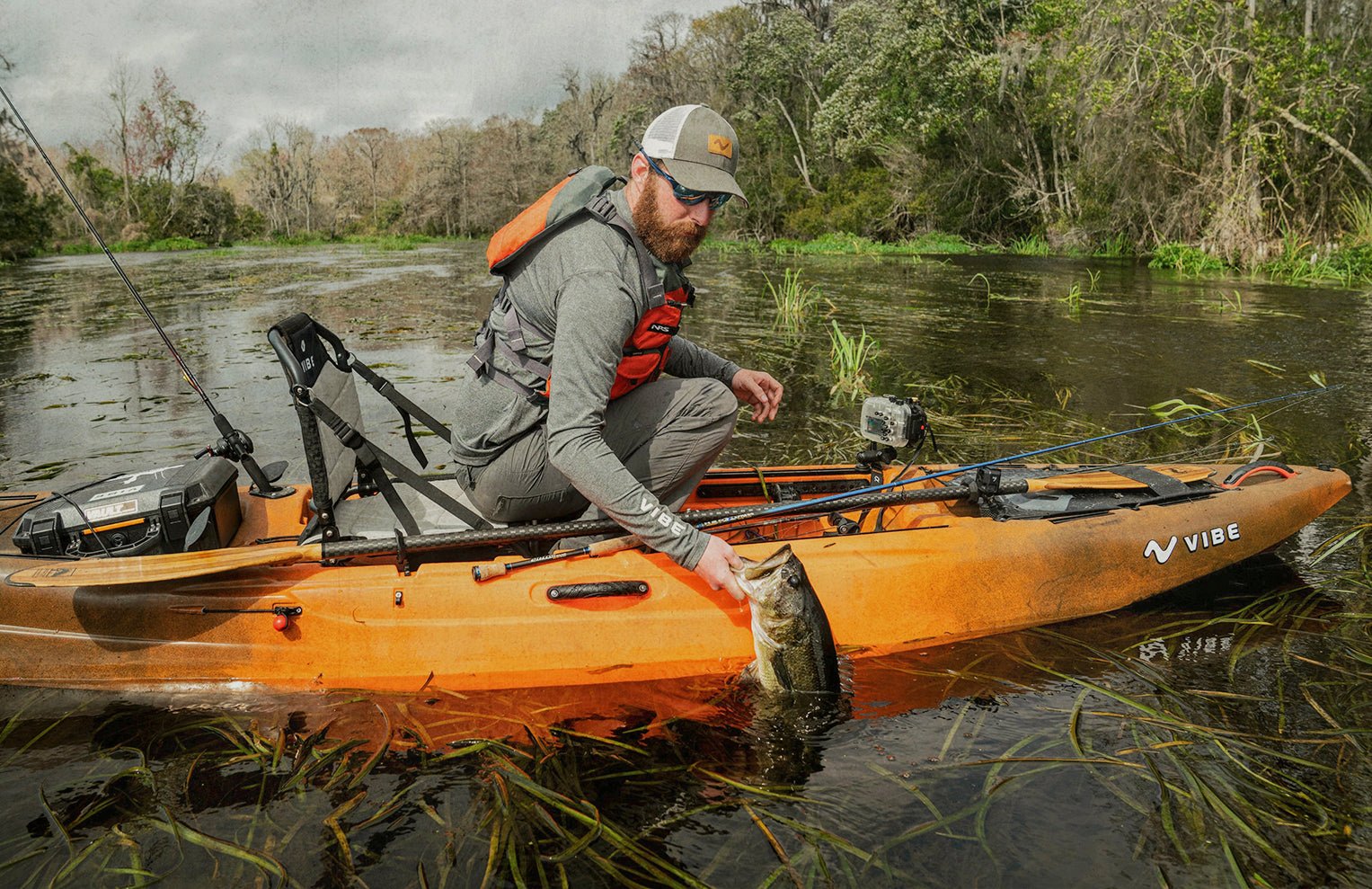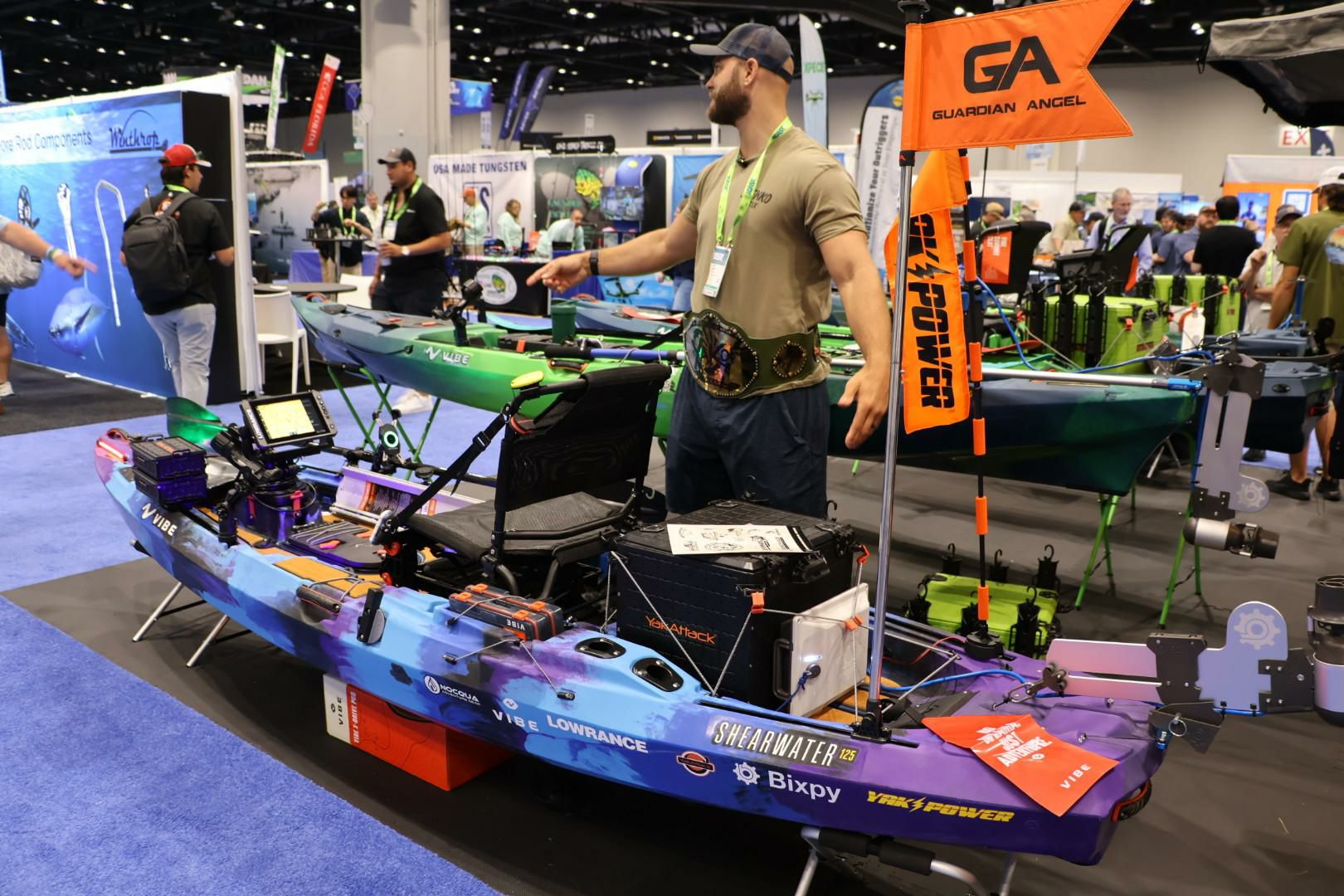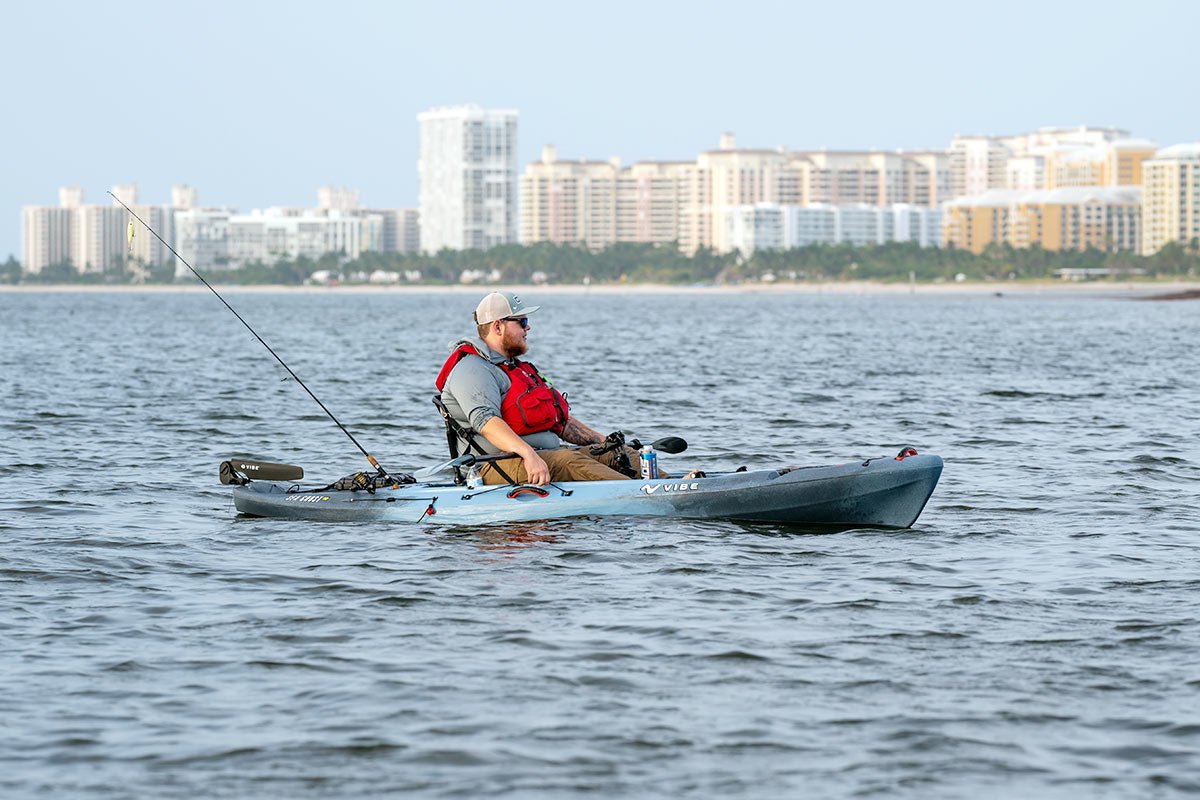How To Kayak Fish For Bass: Advanced

Now that we have finished Bass Fishing 101 lets move on to some more specific information...
We all reach a point in our kayak fishing career, where we realize that we can't get it all done with just 1 or 2 setups. Maybe you want to dropshot in 20 feet of water one minute, and throw big swimbaits the next, using the same rod and reel setup for both techniques while possible, is not ideal, and you will find this out quickly when trying to detect a subtle bite on a drop shot from 20 feet down with a 8ft extra heavy swimbait rod.
So what gear do we need to make our lives easier? We will go over the basic differences between spinning rods and casting rods, reels, and line choices in this article.
Rods:
Spinning vs. Casting the age-old debate: Many kayak bass fishing pros use baitcasting rods for every occasion. Some use spinning rods for more subtle techniques, and some use a mix of the 2 for specific presentations. But why do you primarily see them with mostly casting rods on deck? The answer is simple, power. While people will also say casting distance and accuracy, power is the real difference maker. Baitcasters originally started being used by top kayak anglers wanting more power to wrench those 8lb largemouth out of thick cover. Spinning rods have a hard time with heavier line, anything over 12 lb test mono, or fluorocarbon tends to jump off the spool causing tangles and frustrations. Casting rods can spool some serious weight lines and tend to have the gear ratios to back it up. But does that mean you should hang up that trusty spinning rod and pick up a quiver of Baitcasters? Not necessarily, even as technology allows Baitcasters to become more and more sensitive and lightweight, a lot of people still prefer the feel of a spinning rod for those more finesse techniques. I will catch a lot of flak from baitcaster purists for this, but there are simply some things that spinning rods excel at and detecting that dropshot bite 20 feet down… is one of them.
So, where does this leave us in our decision making? Well what are you looking for in a rod? Do you need something that you can power through the weeds with? Pull that frog quickly over the top of some pads? How about needing pinpoint accuracy to get a jig under that laydown? Maybe you want to better take advantage of the long strike zone fishing the length of a ledge or drop-off? This is where baitcasters will excel. The increased gear ratio choices will give you speed, or power on the reel, while the increased backbone that sits right on the hand will give you the leverage you need to pull them in. But what if you want to downsize your presentations? Going lighter with the line and lure can cause backlashing or tangling in even the most advanced baitcaster, it can be done. But there are better tools for the job. This is where spinning gear comes in, lightweight line, lightweight lures, smaller presentations. Anyone who has spent time fishing for clearwater smallmouth in the fall knows that sometimes the difference between a bite and getting skunked is 1/8oz.
Power and Action: Rods come in all sorts of different power and action ratings, you will often see power listed out as; light, medium, heavy. And action labeled as; Slow, moderate, fast, extra fast. These rules are not set in stone though, each brand uses its own terminology and ratings, so look at this as more of an approximation of how the rod will behave and less as a rule.
Power: Kayak fishing pros will often describe their rods by the power rating, what this translates roughly to is the amount of flex the rod has decreases as the power rating goes up. Ultra-light rods have a lot of flex, extra heavy rods are like fishing with a fence post. Most bass fishermen will choose a medium power rod for their do everything setup because it bridges the gap from super stiff and super flexible. But as the angler progresses to have more technique specific rods and reels you will see them using almost every power rod. Heavy for pitching and flipping, frogging, swimbaiting, Medium Heavy (MH) for spinnerbaits, jigs, deep diving crankbaits, medium as an all-purpose rod, squarebills, bladed jigs (chatterbaits) and shaky head jigs. Med/Light-light for small jerkbaits and topwater soft plastics, dropshots, and general soft plastic slinging.
Action/speed: When a kayak bass fisherman refers to the action of their rod, they are generally referring to how far down the rod the backbone sits. What this really means is when a big fish is on your line, your rod bends, some rods bend at the tip only (extra fast), some bend all the way down near the handle (extra slow). Fast action rods are very sensitive meaning you can detect subtle bites easier, slower action rods will give you more control over the fish while fighting it. They each have their place, and when properly paired to a power rating you can really start to specialize your rod for a certain presentation. Fast action for spinnerbaits, topwater, frogging, pitching. Moderate actions for crankbaits, bladed jigs and flipping. Slow action for swimbaits, and you will meet two types of people, those who drop shot on an extra fast, and those who prefer an extra slow, not many people will choose something in between the two.
Reels:
When choosing a reel to pair with either your spinning or casting rod there are a few factors to consider; Size, and gear ratio need be considered for both types. For casting reels there are a few more things to consider such as braking, and spool tension control. Once the thumb bar is depressed on a casting reel the spool is free to spin in either direction, a free spinning spool will give you the ability to cast for a mile, but can also be the cause of some frustrations with certain techniques as well as when you are learning how to use a baitcaster, so spool tension knobs exist to help you slow down that free spin so you can focus on your casting motion and thumb to spool technique. Brakes are for the end of the cast, and there are 3 major types on the market, magnetic, centrifugal, and hybrid. Brakes slow the spool down towards the end of the cast which prevents the spool from spinning too far and causing serious frustrations. There is no fast and hard rule for which is most effective for any given brand, they are all slightly different in their approach. For the most part magnetic braking is the easiest to adjust and dial in as there is usually a knob on the side of the reel allowing you to just dial in the brake strength without taking off the side panel.
Gear Ratios: Simply put, the gear ratio is how many times the spool turns for each turn of the handle. Lower speed gear ratios will also usually be a bit more “powerful” because the ratio creates more torque. A lower gear ratio reel is ideal for big baits that pull a lot, such as deep crankbaits. These reels have the highest amount of torque, allowing you to put less effort into retrieving the bait and more energy towards finding the fish. If you’re fishing any lure that you primarily work with your rod, a high gear ratio reel is the way to go. You’re often pulling the bait with your rod tip, but you need to have the ability to quickly take up your slack when you get a bite. A fast reel also helps when fighting a big bass when you need all the speed you can get in order to quickly pull it away from pilings and docks or other cover that might be rubbing your line raw.
High speed gear ratios (7.1:1 and up) for: frogging, jigs, big worms, shaky heads, Texas rigs, topwater baits, jerkbaits, lipless crankbaits, and running near top water spinnerbaits and buzzbaits.
Medium speed gear ratios (6.1:1 through 6.5:1) for things like: squarebills and medium depth crankbaits, shallow spinnerbaits, shallow castable umbrella rigs.
Low speed ratios (5.1:1 through 5.5:1) for: Deep crankbaits, big swimbaits, deep water spinnerbaits.
Line:
Monofilament, Braided line, Fluorocarbon, what are they? Isn’t all line basically the same, the test strength being the only differentiator? As fishing became more and more mainstream, technology caught up making lighter and more sensitive rods, more powerful and better casting reels, as well as more refined and specialized choices for line. You can use braid alone, or in combination with either of the other 2 as a leader.
Monofilament: Mono for short, this is the line your grandfather used, it has been around for a long time. This is the cheapest option on our list, and probably the least likely to be used amongst kayak bass fishing tournament anglers, but that doesn’t mean that it does not have its place. Mono sinks very slowly, so it is the ideal line to use on topwater presentations in open water. It also has significant “stretch” so when you set that hook the line acts like a miniature bungee cord absorbing some of that power. This can be either good or bad depending on the situation.
Fluorocarbon: Fluoro for short. This is the new kid on the block as far as clear lines go. Fluoro is almost invisible in the water which is an advantage for stealthier techniques. It is a stiffer line than mono which means it might be difficult to tie with some traditional knots, it also means there is next to no stretch in the line, so be prepared to lighten up your hookset a little. Fluoro sinks quickly making it great for weightless sub surface presentations, and crankbaits that you want to reach their maximum depth.
Braid: Braid has a VERY high strength to size ratio, which means you can have 50lb test line that measures like 12 lb test mono or fluoro. Simply put, this allows you to have more line, of a higher strength on your reel. Braid is more visible to the fish than either mono or fluoro, which is why it comes in so many different colors, the idea being that certain colors are harder for fish to detect in certain water. Braid has no stretch whatsoever, which is great for transferring that power directly to the fish, and great for detecting the most minute of bites.
Now that we have discussed all these gear basics you should be more prepared to enter the equipment aisle at your local retailer. Armed with information on technique specific gear you can make your decision for what works best for you and the way you intend to kayak bass fish. So, piece together some set ups and get out there. Gear is only one aspect to piecing together your adventure! The rest is up to you!
Photo by: Daniel Nichols



